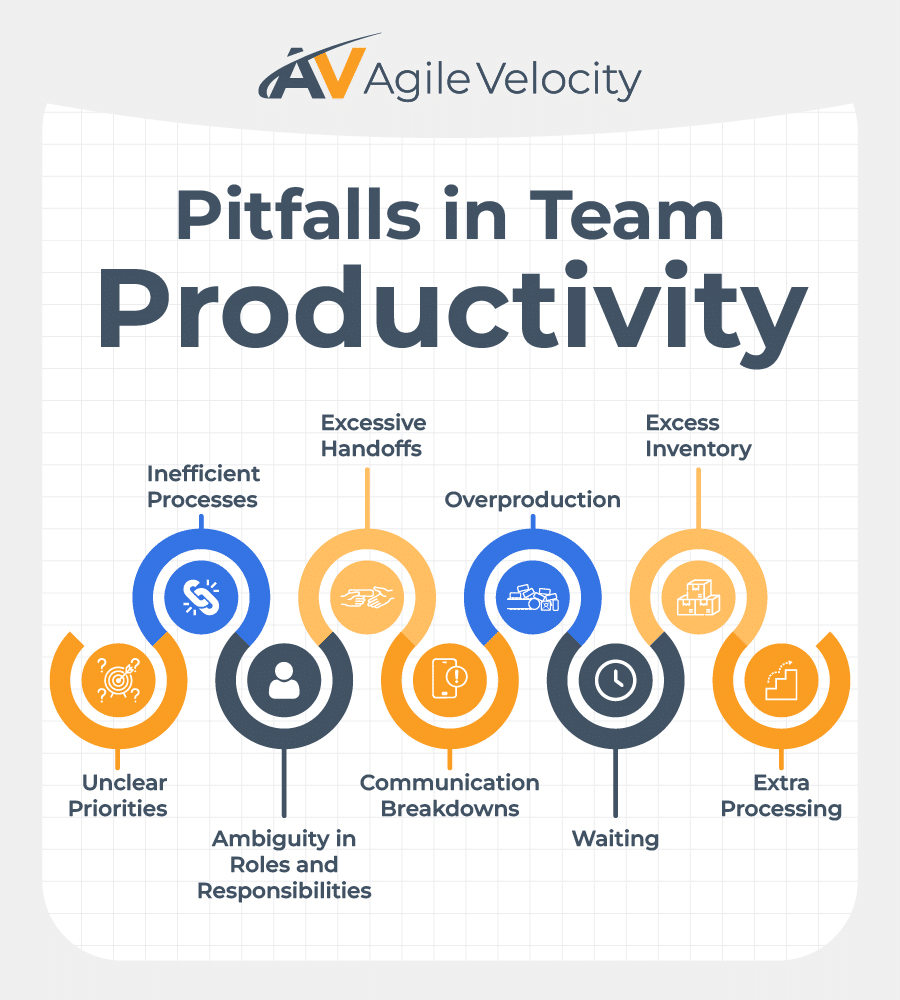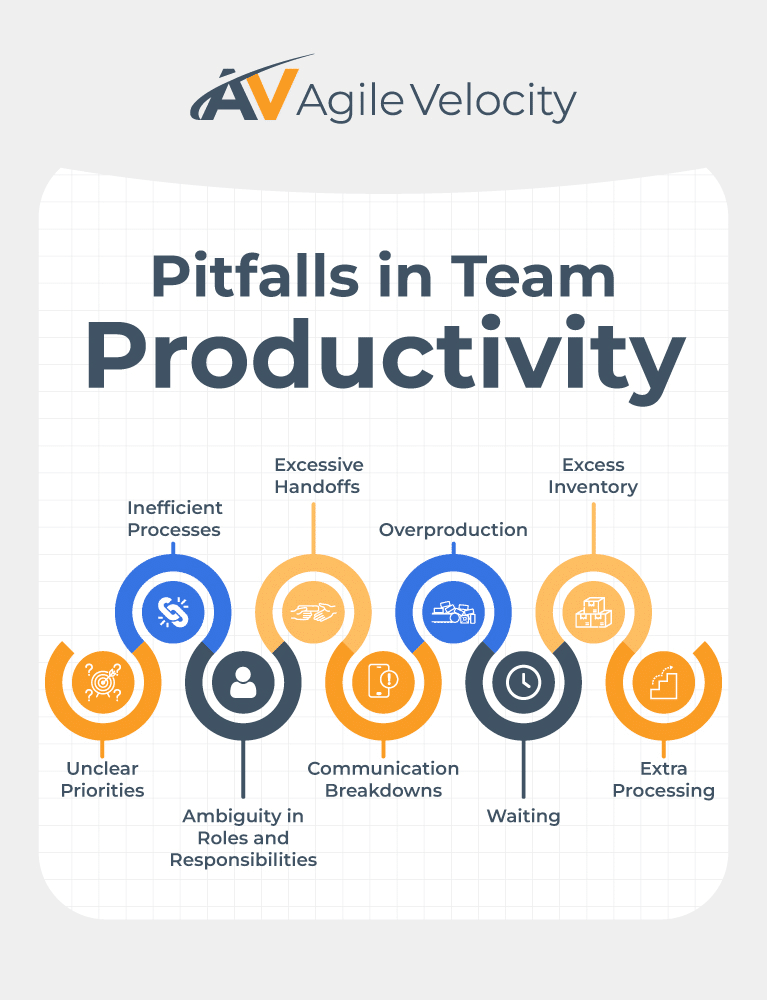Boosting team productivity often feels like solving a complex puzzle. You’re moving the pieces—adjusting workflows, refining priorities—but the full picture can remain out of reach. Missed deadlines, stretched budgets, and overwhelmed teams don’t just harm the bottom line; they signal deeper inefficiencies that need attention. The good news? Proven strategies can streamline your processes and empower your team to be more effective.
By combining Lean strategies and Agile Methodologies, you can eliminate waste, amplify collaboration, and foster an environment that prioritizes value delivery. Add tools like Path to Agility Navigator, and you gain an even clearer roadmap for visualizing, tracking, and implementing improvements.
In this article, we’ll discuss why productivity often takes a hit, the principles behind Lean strategies and Agile Methodologies, and practical steps for diagnosing inefficiencies. You’ll also explore key strategies to eliminate waste, streamline workflows, and align goals across teams. Whether your team is just starting out or already scaling operations, these approaches will help transform chaos into clarity—leading to faster, smarter, and more sustainable results.
Understanding the Challenges of Team Productivity
Team productivity isn’t just about getting work done faster; it’s about creating an environment where teams can align on goals, execute efficiently, and consistently deliver value. However, common pain points often stand in the way:
- Unclear Priorities: Rapid shifts or lack of clarity create frustration and confusion.
- Inefficient Processes: Fragmented workflows lead to bottlenecks and rework.
- Ambiguity in Roles and Responsibilities: When team members don’t know who is responsible for specific tasks, accountability suffers.
- Excessive Handoffs: The more times a task is passed around, the higher the chance of slow delivery.
- Communication breakdowns: Misaligned information or inconsistent updates often force teams into firefighting mode.
- Overproduction: Producing more than necessary leads to wasted resources.
- Waiting: Idle tasks pile up in queues or approvals, delaying outcomes.
- Extra Processing: Unneeded steps or overengineering add complexity and expense.
Issues like these can snowball, resulting in missed goals and declining morale. Recent studies link poor communication and unclear objectives to cost overruns and schedule delays. Identifying these root causes is essential for boosting performance—by addressing them early, you lay the groundwork for smoother workflows and stronger collaborations.
The Role of Lean Thinking and Agile Methodologies in Process Improvement
To create a high-performing team, focus on both efficiency and adaptability. That’s where Lean strategies and Agile Methodologies come into play—two complementary approaches that can transform the way your team works by streamlining processes and enhancing responsiveness.
Lean Thinking: Delivering Value by Reducing Waste
Lean Thinking is pivotal for maximizing customer value by not only identifying but also actively eliminating waste in workflows. To effectively tackle waste, Lean Thinking employs several strategies:
- Value Stream Mapping:
- Map out all steps in your process to visualize where value is created and where waste occurs.
- Identify non-value-adding steps and pinpoint improvement areas to streamline the process.
- Continuous Improvement (Kaizen):
- Encourage regular feedback and small, incremental changes rather than major overhauls.
- Everyone in the team should contribute to finding better ways to conduct experiments and implement enhancements regularly.
- Just-In-Time Production:
- Focus on producing only what is needed, when it’s needed, and to the required standard.
- This reduces overproduction and minimizes excess inventory, cutting down on waste associated with storage and material handling.
- Root Cause Analysis (5 Whys):
- Employ the “5 Whys” technique to identify the underlying causes of wasteful practices.
- Once the root causes are found, implement targeted solutions to eradicate the waste.
- Poka-Yoke (Error Proofing):
- Implement simple, fool-proof solutions designed to prevent errors from occurring at the source.
- This approach reduces extra processing and rework by ensuring that tasks are done correctly the first time.
- Reduced Handoffs and Bottlenecks:
- Streamline workflows by minimizing handoffs which can cause delays and errors.
- Use pull systems that react to demand signals rather than push systems that can overwhelm team capacity.
By employing these Lean strategies, teams can significantly reduce or eliminate waste, resulting in more efficient processes that deliver greater value to the customer. Adopting such an approach ensures productivity gains, clearer workflows, and a nimble organization capable of adapting to change.
Agile Methodologies: Building Adaptability and Sustaining Progress
While Lean focuses on eliminating waste, Agile Methodologies emphasize adaptability, iterative delivery, and frequent feedback:
- Sprints and Iterations: Frameworks like Scrum and SAFe® break work into manageable time-boxes.
- Frequent Feedback: Events such as Sprint Planning and Sprint Review ensure consistent alignment and quick course corrections.
- Retrospectives: Reflection sessions promote continuous improvement and tie neatly to Lean’s waste-reduction mindset.
The Power of Integrating Lean and Agile
Organizations that blend Lean and Agile see more than just faster outputs—they cultivate the flexibility to shift quickly when business needs evolve. They also reduce delays, eliminate duplication, and provide tangible value sooner. For further exploration of scaling Agile, check the Scaled Agile Framework® and discover how it aligns with Lean principles.
Diagnosing Inefficiencies in Current Workflows
Improving team productivity begins with identifying and addressing bottlenecks. Teams often miss hidden issues because they’re stuck in daily tasks. A structured evaluation helps uncover these hurdles.
Steps to Identify Workflow Inefficiencies
- Visualize the Journey: Map how tasks move from idea to completion. This approach helps locate potential delays.
- Spot Bottlenecks: Look for consistent pileups or slowdowns. Using a Kanban Board can reveal precisely where work stalls.
- Gather Team Feedback: Provide open forums for input from those on the front lines.
- Compare Goals vs. Reality: If deadlines are often missed or tasks require repeated rework, pinpoint whether expectations and deliverables are clear from the start.
Identifying inefficiencies lets you target areas that truly need improvement. Let data guide the process: track cycle time and throughput to measure progress objectively.
Eliminating Waste and Streamlining Processes
After spotting where workflows are clogged, zero in on eliminating waste. Categorizing each inefficiency helps you focus on the solutions that matter most.
Focus on High-Impact Areas
If certain steps consistently hold up delivery, tackle them first. For example, unclear acceptance criteria may be driving rework—defining them upfront can cut wasted effort.
Minimize Waiting Times
Waiting is a pervasive form of waste. Shortening wait times yields faster, smoother delivery for your team.
Leverage Automation and Smart Tools
Free your team from repetitive tasks by introducing automation where possible. Explore streamlined AI solutions for processes like data entry or testing. For example, Path to Agility Navigator offers real-time views of progress, helping you identify delays without juggling spreadsheets.
Avoid Overproduction
Overproduction—delivering more than what’s immediately needed—wastes time and resources. Regular Product Backlog refinement keeps priorities current and focuses your team on the most important tasks. Getting regular feedback from your customers and stakeholders in Sprint Review helps ensure you are building just enough.
Simplify Handoffs and Communication
Excessive handoffs breed confusion. Minimize these transitions using a flexible approach and shared documentation. Centralized tools also ensure updates are visible to all.
Prioritize Continuous Improvement
Sustain your gains by embracing ongoing evaluations, such as Sprint Retrospectives or periodic Kanban reviews. This prevents slipping back into old habits and ensures solutions last.
Implementing Efficient Workflows to Foster Team Productivity

Efficient workflows aren’t solely about speed; they’re about building durable processes that adapt well to change. By focusing on clarity and alignment, you equip your team to deliver better results, more consistently.
Set Clear, Measurable Goals
Outline what you want to achieve, then reverse-engineer your workflow to shape those outcomes. For instance, if your goal is delivering an increment every two weeks, ensure Sprint Planning clarifies tasks upfront and responsibilities remain unambiguous.
Foster Alignment Through Clear Communication
Consistent communication is a hallmark of an efficient workflow. Keep tasks and updates in one place:
- Use a Kanban Board to separate planning from actual delivery.
- Rely on a Sprint Backlog for Scrum Teams, ensuring the entire team knows exactly what’s expected.
Leverage Iterations to Stay Agile
Time-boxed cycles—like Sprints in Scrum or Iterations in SAFe—help maintain momentum:
- Keep tasks within manageable boundaries, as suggested in SAFe guidelines.
- Sprint Review sessions showcase progress and gather stakeholder input.
- Ongoing reflection with Retrospectives promotes continuous improvement.
Build an Adaptable Team Culture
A flexible mindset empowers teams to pivot quickly:
- Encourage candid sharing to spark insights.
- Emphasize transparency and willingness to adapt when priorities shift.
With these strategies in play, your workflows become a launchpad for innovation rather than a series of rigid checkpoints.
Leveraging Path to Agility Navigator as a Productivity Tool
When incorporating Lean strategies and Agile Methodologies, maintaining visibility is essential. That’s where Path to Agility Navigator shines. Evolved from Path to Agility®, this specialized platform enables organizations to map Agile transformation efforts, track progress, and define tangible actions for improvement.
Key benefits of Path to Agility Navigator include:
- Clear Visualization: It highlights the capabilities you need, aligning teams and stakeholders around shared objectives.
- Real-Time Tracking: The platform’s insights spotlight issues before they escalate, allowing leaders to address roadblocks quickly.
- Prioritized Next Steps: By analyzing organizational gaps, it suggests areas with the highest impact on productivity.
- Framework Compatibility: From Kanban to SAFe or Scrum, it integrates seamlessly with any Agile transformation framework.
Teams that embrace Path to Agility Navigator often see higher engagement and fewer misalignments. It clarifies what needs to change while helping you track the journey toward optimized workflows and cohesive, productive teams. Watch the video below to learn more about this invaluable tool.
Realizing the Broader Benefits of Process Improvements
Enhancing workflows through Lean strategies and Agile Methodologies offers more than quick wins—it creates lasting value.
- Accelerated Delivery Timelines – Eliminating rework and reducing wait times helps you deliver features or services faster, which can be a key differentiator in competitive markets.
- Enhanced Predictability and Quality – Structured processes clarify timelines and quality benchmarks. This predictability builds confidence among both internal stakeholders and external customers.
- Elevated Team Morale and Engagement – Well-defined workflows empower individuals. When roles are clear and roadblocks are minimized, teams are more engaged and better able to take ownership of their work.
- Support for Scalable, Sustainable Growth – By embedding continuous improvement, you build resilience that scales. Resources spent on firefighting can shift to strategic innovation, fueling ongoing success and adaptability.
Continuous Improvement as an Ongoing Team Mindset
Improving workflows isn’t a one-off initiative—it’s an ongoing process that thrives on consistent evaluation. Each refinement builds on the last, nurturing a culture of learning and adaptability so your team remains prepared for future challenges.
Encourage Teams to Drive Change
Continuous improvement flourishes when every individual is empowered. Agile Coaching can guide team members to surface improvements without fear and help you. Create open forums where ideas are welcomed and tested incrementally.
Let Data Guide Progress
Regularly review workflow metrics, such as cycle time, to uncover hidden inefficiencies. Pairing quantitative data with team feedback provides deeper insights into necessary adjustments.
Build a Culture of Trust and Feedback
Leaders who act on improvement suggestions set the tone for openness. A trusting workplace encourages experimentation and faster iteration, ensuring a robust feedback loop.
Learn from Wins and Setbacks
Every outcome offers valuable lessons. By celebrating improvements and analyzing setbacks, you maintain momentum toward ongoing progress.
Create Space for Ongoing Adaptation
Incorporate regular check-ins during Sprints or Iterations to refine workflow processes. Routine reviews keep changes aligned with evolving business goals.
By instilling continuous improvement as a collective mindset, organizations position themselves to thrive amid change and consistently elevate team productivity.
Applying Lean Thinking to Streamline Business Processes
Maximizing team productivity isn’t solely about speed—it’s about addressing underlying inefficiencies, nurturing collaboration, and employing flexible strategies. Lean strategies and Agile Methodologies, supported by tools like Path to Agility Navigator, help you reveal hidden obstacles, streamline workflows, and deliver greater value with consistency.
Small, consistent refinements accumulate into significant sustainable benefits over time. By eliminating redundant steps, improving communication, and embedding continuous improvement, teams can align more closely with evolving business demands, leading to higher quality outcomes and a more engaged, empowered workforce.
If you’re ready to enhance your team’s productivity and drive meaningful change, Agile Velocity is here to help. With expertise in business operations consulting to build organizational agility, we partner with businesses to simplify the path toward increased efficiency, adaptability, and long-term growth. Your journey to a more productive, empowered team begins today–Contact Agile Velocity today.





